Snow-holing in Scotland has a long established history in both our own winter mountains and further afield. Over the last 10 years, snow-holing has grabbed the attention of the media and the viewing public. This exposure has introduced and encouraged people happy enough to pay for the experience. Andy Bateman* of Scot Mountain Holidays asks, should we assume what works in other mountains will work well in our own?
Likely Ambient Temperature
With the seasonal minimum in some recent Scottish winters approaching -20oC and an official record of –27.3oC, you would be forgiven for assuming you’d might be sleeping in temperatures approaching those of Arctic Norway.
Yet Cairngorm (1245m) has only ever recorded around half of this at –16.5oC (12th Jan 1987). Supporting this, Coire Cais Ski Base Station (630m) has a low of -9.2oC. The residents of nearby Nethybridge (210m) though, claimed the mercury dropped to -31.3oC on 10th January 1982. Satellite evidence suggests they were right!
The vital bit of information on these -30-ish lows are that they were all recorded during temperature inversions. The cold air flowed off the mountains and pooled in the valley bottoms where it cooled further whilst the mountain summits remained appreciably warmer. These record minima are in no way a reflection of the likely temperature you would find on our mountains. It’s not surprising when we’re never that far from a relatively warm sea in the UK!
So what temperature is likely when snow-holing in Scotland, let’s say, in the Cairngorms at around 1100m? The seasonal minimum for 900 m is usually around -8oC. At 1100 m this could translate to -10oC. Far more frequently winter temperatures at this height are around -5 and above. Our mountains simply don’t experience anything like the temperatures you might get in e.g. Arctic Norway.
Considering the warmer temperatures when snow-holing in Scotland, do we really need snow-hole features designed to capture warm air? Are sleeping platforms and cold air drains really necessary or should our aim be to lose the warm air?
Snow is a great insulator. A meter thickness in your roof and front wall is of vital importance in this regard. That is 20 cm of insulating snow both on the exterior and interior surfaces with 60 cm of well insulated structurally sound snow. Light penetrates to a depth of around 75 cm so if you see daylight, they’re getting too thin. It should also be borne in mind that a 1 m thick roof represents a considerable weight. It’s vital the front wall is adequately thick and strong enough to support the roof.
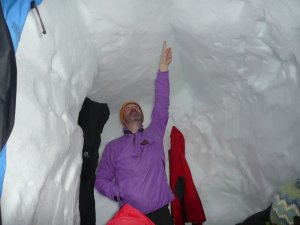
How high is that roof? Look at the apex centre.
Snow-hole sites by virtue of their high snow accumulation and steep slopes can be prone to avalanches. To be safe, you may need to pick a slope with a more gentle gradient and spend more time digging out the entrance. The majority of avalanches occur on slopes at or above 30 degrees. To maintain a 1 m thick roof, on a slope less than this, you’ll have to dig in a minimum 2+ horizontal meters from the top of the doorway before you start widening out the living area.
Avoid large areas of unsupported roof by keeping your snow-hole narrow. Aim for a depth of 2 body widths between the internal surfaces of the front and back walls.
This means you can create a relatively steep-angled apex ceiling which helps to avoid any drip points. Warm air can then be channelled towards the ventilation holes at the apex high points. In addition with it running the length of the snow-hole it increases the height with minimal snow removal giving everyone the opportunity to straighten their weary backs!
Importantly it also removes the unsupported dead weight from the ceiling. This is one of the most important aspects of snow-holing in Scotland. Although not mutually exclusive, removing the ceiling dead weight is of more importance to ceiling stability than temperature! Very few, experienced and inexperience alike, pay attention to removing the dead weight. I’ve managed to snow-hole once at +5 Deg C without any roof deformation! The roof of a snow-hole I constructed for the BBC Travel Show lasted through until around the 25th June!! The ceiling at that point was only a foot off the floor, but it hadn’t collapsed!! Every other snow-hole at that point was merely a hollow in the snow. As you create the apex be careful not to make the roof too thin. The strength of the roof is in it’s thickness.
Make sure there is good ventilation. My test is to regularly watch my breath. If it drifts off to one side it’s a good indication that ventilation is adequate. Cooking with pressure stoves in a poorly ventilated snow-hole is extremely dangerous due to the formation of toxic Carbon Monoxide. All pressure stoves work by first oxidising the fuel to Carbon Monoxide (CO) and then to Carbon Dioxide (CO2). The different colours in the flame indicate this. Irrespective of good ventilation a pan of icy water can have a severe quenching effect on the flame preventing combustion of the CO. Research for the British Antarctic Survey (BAS)** showed in heating a pan of icy water CO production could be significantly reduced by raising the pan supports higher above the flame. Snow-holers should acquaint themselves with the symptoms of CO poisoning.
To put this into perspective, I’m unaware of anyone in the last 25 years dying from CO poisoning whilst snow-holing in Scotland. I do know though, instructors who’ve attributed head aches to possible CO poisoning. It’s worth considering taking a small portable CO detector with you. In a snow-hole with a single entrance and no through air movement, ventilation may well be inadequate. Extinguish candles before you go to sleep as they also produce small amounts of CO.
Although the temperature may remain around 0oC you may well still be “injecting” appreciable heat energy into the snow pack. It takes considerable heat energy to turn snow at 0oC into water at 0oC so it will not be reflected in a temperature rise. It’s far more desirable that this heat energy drifts out of the doorways than being absorbed by the snow pack.
Make it large enough to stand up in. Large communal snow-holes are less prone to an abrupt temperature rise as they have better ventilation characteristics by virtue of having several entrances, etc. An entrance walled up with blocks in combination with an open doorway will often still allow plenty of ventilation.
Putting aside the dangerous scenario of cooking in a poorly ventilated snow-hole, I’ve never got up in the middle of the night to purely unblock a doorway for ventilation reasons. All the medical research I have seen (references below) doesn’t suggest there is any potential of becoming severely hypoxic in your sleep. Studies suggest sleep will become agitated, you will awake and in doing so get up and ventilate a stuffy snow-hole.
One potential hazard of digging a small snow-hole is you don’t have enough space to put the snow as you attempt to extricate yourself after a night of severe drifting. On one occasion I did have to tunnel out 1 ½ m before I hit the surface!
When it comes Scottish snow conditions, don’t underestimate how hard the snow can get. You will need a snow shovel with a metal scoop and a good snow saw. The sintering effects of strong sunlight and hard frosts of high pressure can make wind-slab snow astonishingly hard to dig. A good snow saw is often the only effective way to deal with this type of snow.
Many of the snow-hole sites are immediately adjacent to water courses. In addition, the snow pack often lasts well into the summer meaning there’s little opportunity for biological breakdown of human waste. If you do have to go you should do your business well away from the snow-hole site and far more preferably have some system to carry it out. Cairngorm Mountain’s Snow White Project has greatly improved the situation at the Cairngorm sites. All snow-holers coming to the Cairngorms are encouraged to use it.
The safety of a snow-holing in Scotland is often a reflected by the time it has taken to dig. I’m cautious about suggesting how long digging should take as it depends on a number of factors, not least the condition of the snow. From a “duty of care” perspective I feel a large communal snow-hole is much better than several separate small ones. I normally anticipate spending 4 to 5 hrs digging a 4 plus person snow-hole. I accept in soft snow conditions that this can possibly be shorter for a fit party of 2 each digging their own entrance.
With the vagaries of the winter weather, if done correctly Snow-holing is often the far safer option compared to a tented high camp in Scotland’s Winter Mountains.

* Andy holds the WML and IML awards and has over 20 years Mountain Leading experience. He has guided well over 30 commercial snow-holing trips in this time and although none of the mountaineering qualifications have a remit that covers snow-holing, he is one of the few guides deemed competent by HSE criteria of “relevant experience” to run snow-holing trips.
** British Antartic Survey helped in a BSc thesis. Available on request from andrew@scotmountainholidays.com
Medical references:
www.ncbi.nim.ni.gov/pubmed/18665947
www.ncbi.nim.ni.gov/pubmed/9340627
www.ncbi.nim.ni.gov/pubmed/8355417
www.ncbi.nim.ni.gov/pubmed/15265339
When you think of snow, it’s easy to picture adrenaline-filled days of skiing or snowboarding. But what if you’re not a fan of the slopes or simply want to try something different? Scotland offers a winter wonderland full of thrilling alternatives that let you embrace the snow in unique ways.
Here are Scot Mountain Holidays’ top four snowy adventures for non-skiers, perfect for creating magical winter memories.
Hiking isn’t just a summer activity—winter hiking offers a whole new level of magic. With snow-dusted trails and tranquil, crowd-free paths, it’s the perfect way to experience Scotland’s rugged beauty in its most serene form.
Yes, winter hiking comes with challenges, but the rewards are extraordinary. Picture yourself surrounded by glistening peaks, breathing in crisp mountain air, and savoring the quiet that only snow can bring. Just be sure to bundle up and prepare for the elements!
For those craving adventure with a side of learning, Scot Mountain Holidays offers snow skills courses that are as practical as they are exhilarating.
From mastering ice axes to building emergency snow shelters or navigating icy terrain, these courses give you hands-on experience that’s both empowering and fun. Not only will you leave with stories to tell, but you’ll also pick up life-saving skills that every winter enthusiast should have.
Not every snowy adventure needs to be a grand expedition! Sometimes, the best memories come from simple, joyful moments.
Spend an afternoon building a snowman, crafting the perfect snow angel, or engaging in a good old-fashioned snowball fight. If you’re traveling with kids (or just feeling like one yourself), grab a sled and race down a snowy hill.
End your day by cozying up by a roaring fire with a hot drink and a good book. After all, there’s nothing like the warmth of home after a day of snowy fun.
If you’ve never tried snowshoeing, you’re in for a treat! Imagine strapping on tennis racket-like footwear and gliding effortlessly across snowy trails and frozen terrain. Snowshoeing is easy to learn, beginner-friendly, and a fantastic way to immerse yourself in Scotland’s breathtaking winter scenery. However, the snow conditions on the Scottish hills are not always suitable for snowshoeing which lends itself more to the soft powder snow you find in the Rockies or the Alps. It’s far more common to see winter hikers in Scotland out with crampons and an ice axe, than it is to see a group of snowshoers.
From snow-covered peaks to quiet, magical trails, Scotland is the ultimate destination for winter lovers. With Scot Mountain Holidays, you can enjoy a range of activities designed for adventurers who want to experience the snow without strapping on skis or a snowboard.
So, whether you’re trekking through glistening forests, learning new skills, or simply playing in the snow, Scotland promises a winter escape like no other.
Ready to trade the slopes for something different? Let Scot Mountain Holidays help you craft your perfect snow-filled adventure!
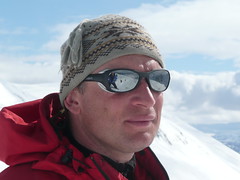
Andy Bateman has instructed and guided for over 25 winter seasons across Scotland. At times its blue skies and a winter wonderland but being based in the Cairngorms he is no stranger to the sometimes uncompromising conditions that can be encountered on Scotland’s high mountains during the winter months.
Putting aside the obvious need to dress properly for the conditions, here are a few of his expert winter skills tips:
Unless your rucksack has a facility specifically for carrying crampons safely on the outside, they should be in a crampon bag inside your rucksack when not on your boots. They are heavy items of kit and can easily work loose when attached with exterior straps or bungee. Crampons carried on the outside can also be a source of injury for other members of the party e.g. in high winds.
The snow and ice conditions can be as varied as the weather that creates them. Don’t limit the techniques at your disposal before you’ve even set foot on the mountain by wearing bendy boots. A key and often overlooked feature of a stiff boot is that it allows you to concentrate your weight on the edges of the sole so you’re able to use them to cut into the snow surface. Your boot is as much a tool as your ice-axe or crampons. B1 “winter” boots are often too flexible to effectively kick steps in hard snow; if you try to front point, the toes tend to bend up and the heel drops causing the wearer to feel unstable. Fully rigid B3 mountaineering boots don’t feel overkill for a winter mountain walk.

Crampons at work
There are a few situations where a long shaft is an advantage but they are outweighed by the number of situations where a short shafted axe is your best bet. Go for an axe with a relatively straight shaft and no longer than 55cm irrespective of your height.
Remember in winter trekking your rucksack will be heavier, plus the extra weight of winter boots and crampons on your feet, the underfoot conditions and having to check the map more frequently all conspire to slow your pace. On top of this there are fewer daylight hours. It’s important that you’re not over ambitious with your route plan to prevent being caught out. Always make sure you have a decent headtorch.
Your rucksack is already heavier with all the necessary gear required by winter. Heavy boots, crampons and underfoot conditions will sap energy and slow you down. Don’t burden yourself further with superfluous kit by considering whether an item is really necessary for the day. At the same time, be sure you have everything you need.
 Full moon Snow-hole Expedition winter gear
Full moon Snow-hole Expedition winter gearEven with an insulated jacket around the tube, once the temperature drops below -3 deg C hydration bladders tend to easily freeze. You are better off with a water bottle in your sack as close to your back as possible to receive a little body heat. Better still take a thermos flask.
There are situations where an ice axe leash is an advantage but there are also a good number of situations where they can be a hazard. Have an arrangement where the leash can be easily added or removed from the head of the axe, i.e. tie a loop in the end of the leash and larks-foot it through the head of the axe. When you aren’t cutting steps or climbing the leash is probably best kept in your rucksack.
Remember, as your core temperature cools your body reduces its circulation to your extremities, like your hands. If you have cold hands, it may well be worth considering putting an extra layer on, as well as warmer gloves. If the body is compensating for a cooling core, to a certain extent, it doesn’t matter how well insulated your hands are, it’s not going to send anymore warm blood to the extremities.
Your body can burn up 40% more calories just by keeping itself warm. Underfoot conditions and heavy gear add to your body’s energy demands. Standing around for more than 10 minutes can mean folks start to get chilled. Schedule-in regular breaks where possible. I find a 10 min break after approximately every 80 min of walking is optimal. You need good judgement and one of the most sensitive organs in your body to a drop in temperature or a lack of energy is your brain. It needs to be well nourished by both.

Striding out to conquer the winter Cairngorms
Why do it? Because this is why it’s worth it.
Have you ever wondered what all the fuss is about? Scotland. Why? Especially in winter must be far too cold and far too dangerous. Take a look – yes, it’s proper winter but isn’t that preferable to wet rain, umbrellas and grey days with little to differentiate between summer and winter, except for the lack of leaves on the trees.
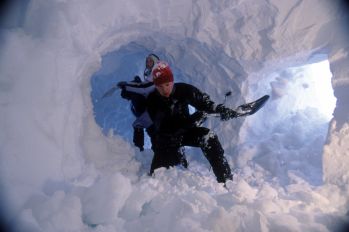
Photo Credit: Paul Tomkins/VisitScotland
Digging out a snow hole site in the Cairngorms under the guidance of Andy Bateman of Scot Mountain Holidays. It’s not quite Sweden’s ice hotel as you have to create the living space yourself, but they’ll have a relatively comfortable night out of the wind, cocooned in their sleeping bags enjoying being cooked for and served a three course meal by their guide.

Build your own snow hole in the Cairngorms
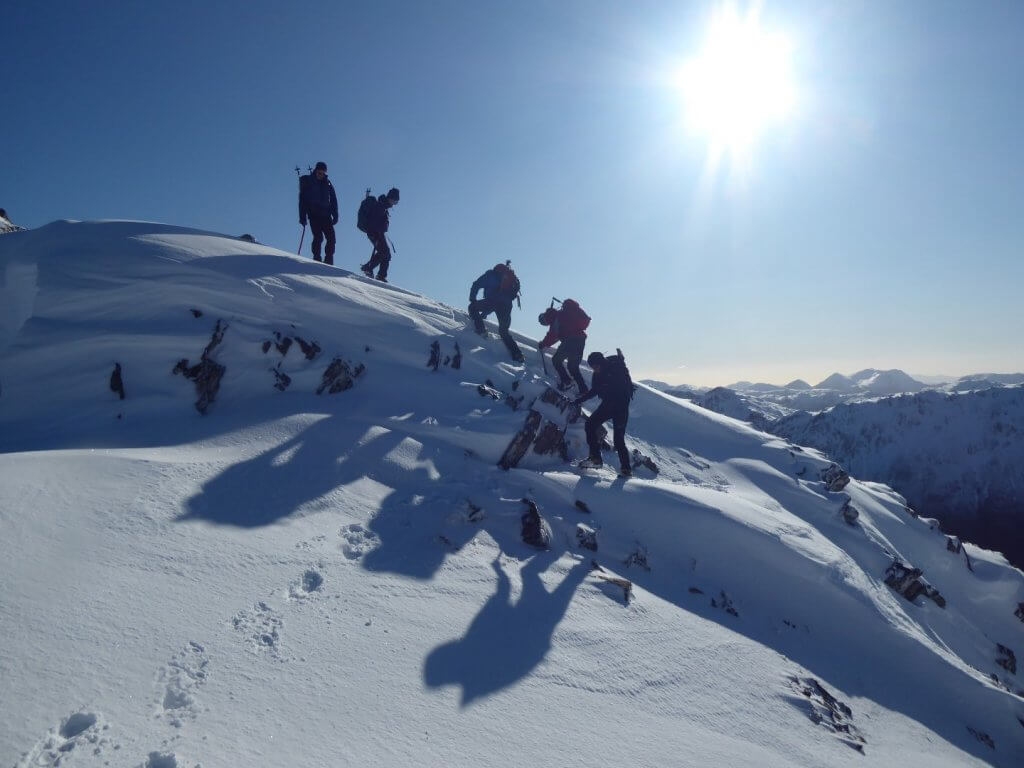
Hiking along the ridges of Argyll, Kintail or Glencoe – space to yourself away from all the crowds and views which stretch for miles under clear skies. We often visit the west coast of Scotland in March to bag some winter Munros: we’ve run trips in Argyll, Glencoe and Kintail. For this year’s offering check the calendar or the Munro bagging page. Some of our clients have left from these trips with the most spectacular images – but those are for another blog.
Photo credit: Dave Downing
The beauty of Glenmore in the winter. Snow laden trees and cross-country skiing opportunities. Short days are not always a disadvantage as they allow for the most spectacular photographic opportunities, as seen above.

Safety skills for walking in the winter hills, demonstrated here by Andy Bateman – ice axe arrest. Legitimate playing in the snow, but as part of a learning process on how to avoid a sliding fall.
Scotland on a cold, clear, crisp day in winter. What’s not to like, especially if you like to take stunning pictures.
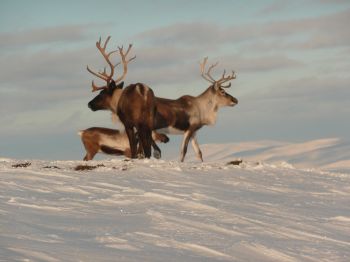
The Cairngorm Reindeer herd in their natural environment. When out walking in the Park, you can come face to face with the reindeer who roam the hills in winter.
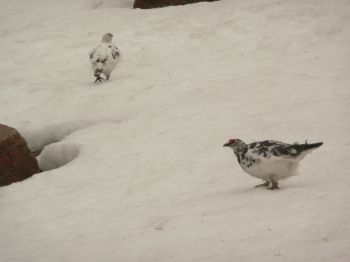
The Scottish Munros, particularly the Cairngorms, are the only area of the UK where you can spot Ptarmigan. Ptarmigan change their plummage twice a year – they have a summer coat, a breeding plummage and a winter coloration to blend in with the snow. You can almost step on the Ptarmigan sometimes as they like to conserve their energy by walking rather than flying if they can and they nest on the ground – there being no trees at the elevation where they are found.
a chance to savour some of Scotland’s most famous and unique produce. Haggis is a traditional meal to celebrate Scotland’s greatest bard, whose influence can be found everywhere from the Birks of Aberfeldy (where there is a thinking/writing seat dedicated to Rabbie Burns) to the Winking Owl in Aviemore, where the great bard is said to have taken breakfast. You might not even be aware of his influence on your own life from: “And we’ll tak a cup o’ kindness yet, for auld lang syne” – which you’ll have sung if you’ve ever brought the New Year in; to “O’ my luve’s like a red, red rose, that’s newly sprung in June” and a special Scottish grace for a meal: “Soem hae meat and canna eat And some would eat that want it. But we hae meat and we can eat, sae let the Lord be thankit.”
Burns Night is 25th January and is celebrated throughout Scotland with a haggis meal and the address to the haggis – written by Rabbie Burns.
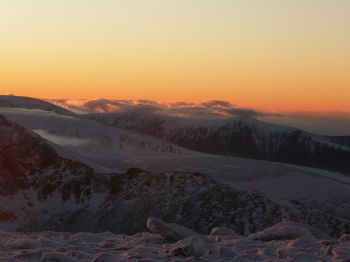
Scotland is famous for the colours of heather in the summer but the winter can be colourful too. This is the time of year that you’ll get to appreciate the sunset. The snow also reflects the light of the moon & stars if the sky is clear, so a night out in winter can be glorious.
snow will entertain the kids for hours and cost nothing, but make sure you’re well stocked with socks, gloves and hot chocolate!
Useful links:
Snow related activities for kids:
Free mountain weather service:
Met Office forecast for the hills:
Scottish Avalanche Information service:
One of our reasons for moving to the Cairngorms was that we knew we would experience a “proper” winter i.e. snow. None of this wet and slightly cool weather which seems to characterise winter in the London area. No we wanted proper snow. That white stuff which seems to terrorise the rail network and bring London to a grinding halt. Here in the Highlands it can be something to be enjoyed. Fortunately there are others who are of the same mindset as us and look forward to a proper winter season so they can dust off their skis or crampons or snowboards.
Plenty of winter fun to be had here in the Cairngorms. Here’s just a small selection of activities you could enjoy:
Sonja, Cormac and Katie came to visit Fraoch Lodge Dec 2012 to early New Year 2013. Cormac was booked on our Hogmanay Winter Skills trip as a treat for his significant birthday; which left Sonja and Katie to fill the week with their own activities. They managed to keep themselves very well occupied for the week. Katie even tried to roll her own pasta one evening. She was very pleased – so much more to report back to her friends than she expected.
Sonja kindly agreed to write up their adventures here:
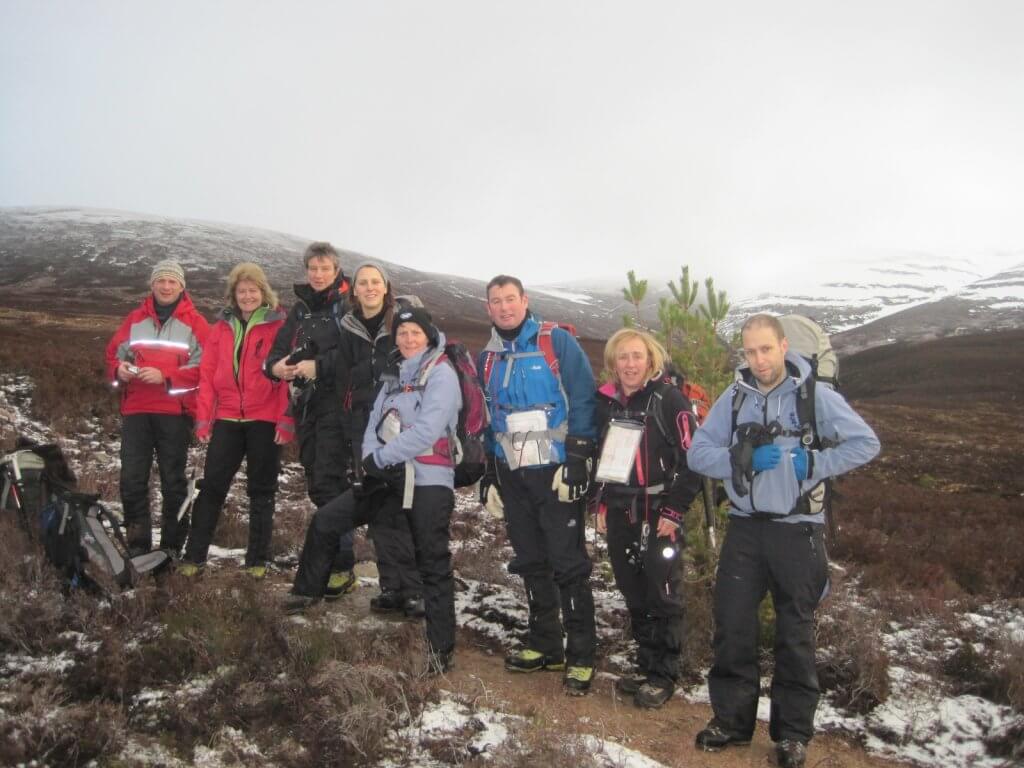
Navigating on New Year’s Day
Cormac’s big birthday was fast approaching and I had no clue what I was going to do. He is an avid hillwalker and mountaineer so I felt something in Scotland might be a good plan. We spend quite a bit of time in the Glencoe area so I wanted to try somewhere new. The Cairngorms National Park seemed the obvious choice. I had spotted Fraoch Lodge while surfing ‘the net’. The idea of a Winter skills courses combined with freshly made homemade bread appealed to me straight away.
I enquired online, then Andy (one of the proprietors) responded to me straight away. He answered all my queries and came back with an excellent price for two adults and a child for a week’s stay with a course included.
So Cormac would be yomping around the Cairngorms for the week, digging snow-holes and cutting steps etc. Now what to do with a nine year old adventuresome type girl?
We decided a spot of snowboarding would be just the ticket.
We set off for Scotland early on the 27th of December and caught a ferry from Belfast to Stranraer. Our drive was scenic but uneventful. Upon arrival at Fraoch Lodge, wee Gregor, a roaring fire and tea and cake greeted us. This was all very, very welcome after a 12 hour journey in the car. Each afternoon we would enjoy a variety of cakes in front of the fire. This quickly became my favourite part of the day.
Soon the rest of the Hogmanay group arrived. We all met in the dining room for a hearty two-course dinner with our hosts. Plans were made for the next day and most of us retired to bed or the cosy warmth of the sitting room. Our rooms were great, clean, comfortable and warm, which just added to our sense of being in a home from home.
The next morning dawned bright and clear. Katy (the adventurous nine year old) and I, set out for Aviemore to the local tourist office to find out what was available to us in the area. We were unable to go snowboarding due to the gusting winds up at the piste.
We met a really delightful man in the tourist office who was courtesy and friendliness itself. He gave us a number of pamphlets and outlined so many things that were on offer in the area. We booked tickets for the wildlife park the next day. That day followed its usual pattern of delicious cake, hearty grub and interesting and fun conversation with the other guests.
The next day, packed lunch in hand, we set off to The Highland Wildlife Park. We had never seen such an array of exotic animals before from Polar Bears to Bactrian Camels and everything in between. The park is a wonderful day out with so much to see and great talks at feeding time. Katy thoroughly enjoyed herself and we had no trouble whiling away an entire day there.
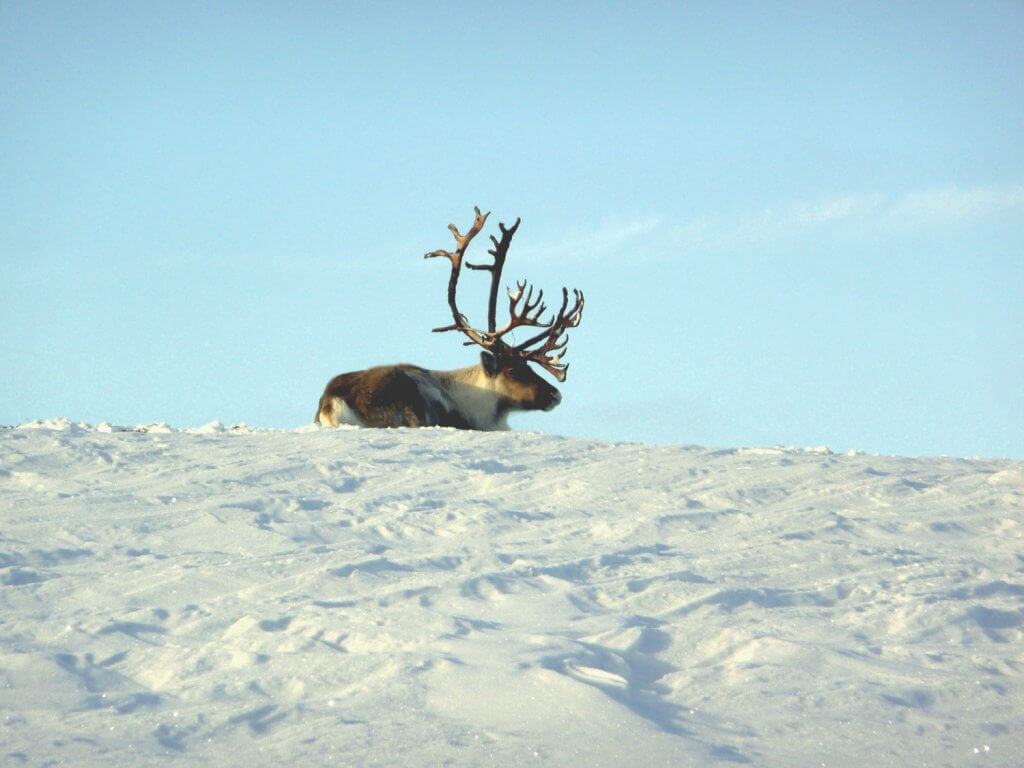
Always a memorable site – the Cairngorm Reindeer herd
The next day the winds continued to stymie our snowy plans so we headed up to The Cairngorm Reindeer Centre. I think this was one of Katy’s favourite activities.
We went out to the little paddock set off to the side of the centre and saw a number of reindeer but the real treat was to come. Everyone followed the staff up in convoy to a car park someways up the mountain. We hopped out and were given a brief talk (it was chilly) about the plan and off we set. We went down a winding trail to a beautiful river, across the wooden bridge and up the other side. This lead us into the foothills of the Cairngorms. Soon we were surrounded by a herd of 200 reindeer all looking for attention and of course the food pellets that they knew we had.
It was a wonder to see these majestic creatures up so close, particularly after the long hard Christmas they had just had. They seemed to be enjoying their well deserved break from their North Pole duties!
That evening I was really touched to see that Rebecca had gone to a lot of trouble for Cormac’s birthday. She had prepared his favourite chocolate biscuit cake (with candles) for cake o’clock and put up birthday banners in the dining room.
The next day, still unable to snowboard, we hit Aviemore. We treated ourselves to big steamy cups of hot chocolate and a spot of sledding in the town. We planned to go dog sledding the next day so we relished the idea of a relatively easy day spent at home in front of the fire.
The next day we set off for The Cairngorm Dog Sled Centre. This again was easily one of Katy’s favourite experiences. After a long talk by the owner of the centre who is a real character and very passionate about his dogs we set out on a motorized vehicle that was ‘pulled’ by a team of sled dogs. It was exhilarating and we loved every minute of this activity.
We spotted a huge stag watching us, as we flew past him with the dogs running as though their lives depended upon it. My only advice for anyone planning on partaking in this activity: bring a lot of very warm clothes.
That night, after a feed of Haggis, tatties and neeps, we set out for the local Ceilidh with the rest of the guests from the Lodge We had a really wonderful night of dancing. Katy came with us and managed to ‘Auld Lang Syne’ her way into the New Year but we retired home moments after the clock struck twelve. She was all danced out.
On our last day Katy was feeling a little under the weather so she, wee Gregor and I had a duvet day. We spent the day lazing in front of the fire wrapped up in sleeping bags, drinking hot chocolate and eating cake. A perfect ending to a wonderful week in the Cairngorms.
I have absolutely no hesitation in saying that I will return to Fraoch Lodge to spend more time in that lovely part of the world. We barely touched the surface with regard to what can be done in the area. We still haven’t snowboarded there so that will need to be experienced. In fact I plan on doing the snow-holing weekend with the expert himself, Mr Bateman and the Winter Skills is also on my wishlist. Can’t wait!
For the full range of walking holidays and skills courses offered by Scot Mountain Holidays please check here.
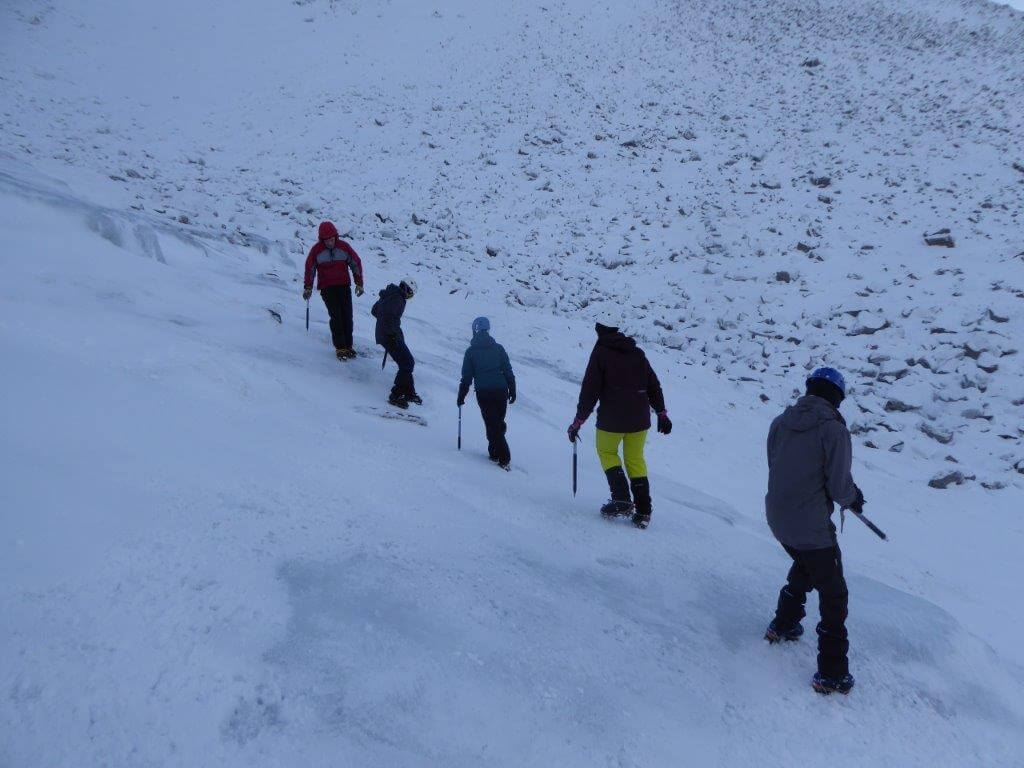
It’s now middle of November and winter in our mountains is knocking at our door. As the Atlantic storms pass our area the arctic air is drawn into their wake. With each passing front, the weather can be extremely changeable. It may be weeks yet before winter conditions are in full nick for full on winter walking, but sudden blizzards on the high tops are now common place – meaning the ill prepared can be easily caught out. Scot Mountain Holidays guide and instructor Andy Bateman takes us through some of the considerations over and above the essentials of ice axe and crampons in transitioning from autumn in winter trekking conditions.
It is prudent to carry a head torch at most times of year, but especially in the case of winter. The days are short and even a minor delay can make the difference between coming off the hill in the daylight and dark. Don’t go without!
In addition, make sure the batteries are fresh so your torch is working at full power. Carry spares too but try to avoid fumbling about to change batteries in a blizzard!
Consider upgrading your head torch to a more powerful model . Remember you may be trying to discern navigational features both in the dark and in the fog.
The stiffness of the winter boot is an integral part of ensuring crampons can be securely attached to your feet. This being said, bunging crampons is not a “fix all” and the winter boot is as much a tool on your foot as the ice axe is in your hand. You need adequate stiffness to kick steps comfortably and efficiently into hard snow. Without it, it will be difficult to execute the technique of front pointing safely.
Proper winter boots are also better insulated. If you’re thinking about buying a boot for the winter go for at least a B2. A B1 boot may be fine for a serious summer glacier trek in the Himalayas, but they don’t come up to the mark when it comes to winter in the Scottish mountains.
Check the state of your soles. It’s those sharp right angled edges that help to prevent slipping and allow you to kick steps.

Which boots to choose for winter?
These are an absolute must and in our damp mountain climate they need to be anti-fog (double lenses). It may be uncomfortable – but not impossible – navigating into driving rain, but don’t underestimate how painful this is once precipitation turns solid. It can be literally impossible to see. Your sight is of vital importance so don’t skimp on the goggles and head torch.
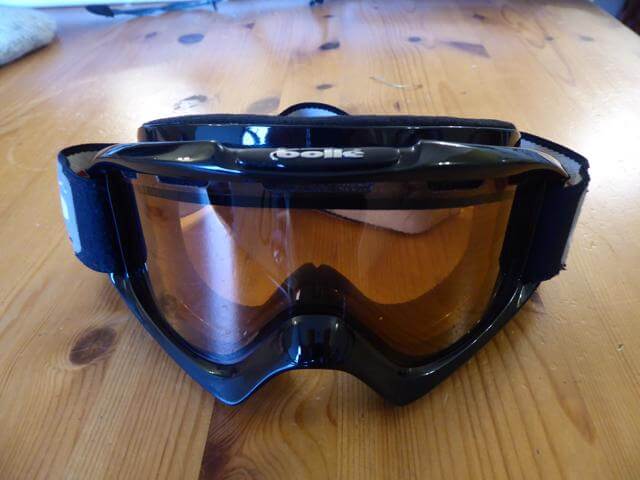
Pack that extra warm layer. The ambient temperature at 1000m rarely drops below -10 degrees C but don’t underestimate how cold it can feel. A weak winter sun, the damp air and often a high wind chill all conspire to make the British mountains one of the worst places for hypothermia. You can chill quickly when you stop moving. A really thick fleece or over layering jacket is ideal. Be cautious about wearing duvets jackets under other garments – they can loose their loft and hence insulation.
Make sure you gloves are warm enough for winter walking … i.e. they must be proper thick gloves. Not only do your hands have a very large surface area compared with their volume but also the body will reduce the circulation to them to conserve the core temperature – no wonder they get cold! So if you do have cold hands don’t just think of putting on warmer gloves, but also an extra layer on your body.
Also remember if you do particularly suffer from cold hands, mitts are better at giving you the option of adding heat pads.
If you’re coming on a winter skills course or winter walking holiday with Scot Mountain Holidays please don’t hesitate to contact Andy if you have any further questions, an expert in optimal gear.
Andy will be publishing further blogs on the subject of preparing for winter over the forthcoming weeks. Keep your eyes open!
You can also take a look at our Winter walking holidays, Winter Skills courses and Full moon Snow-hole Expedition.

In February we ran a snow hole expedition, the second of the year, in the Cairngorms.
The group was small but unusual.
Ian – our most frequent flier on the snow hole. This was his third snow hole trip. Ian first joined us in 2006 to attempt an overnight snow hole in the Cairngorms National park. The weather was against them on that trip and they had to turn back without reaching the snow hole site. The ski area wasn’t open and though the group attempted to ascend the hill they eventually had to turn back after being blown around a wee bit too much. There is video footage from their endeavours which makes for interesting viewing just to see the effect of nature, if nothing else. Ian returned again in 2007 with 90% of his group to try again – successfully
Andy – our oldest client to date on this trip – a celebration of his imminent 70th birthday.
Hui – our first guest from Singapore. A lone female traveller spending a few months in the UK on a sabbatical from her studies.
Read all about their experience in Andy’s words:

Late last year whilst at David Lloyd’s (gym), I said to my friend, Ian Thorpe, an experienced walker and climber, that I fancied carrying out some serious winter walking, but not climbing. Ian replied “Let me take you to the Cairngorms National Park, Scotland.” This was duly arranged by ian and off we set on 21st February at 10am, arriving at Fraoch Lodge in Boat of Garten, in the Cairngorms, at 16.15.
Rebecca, Andy and wee Gregor made us extremely welcome; dinner was baked salmon with a rich and wonderful sauce, followed by home made trifle containing shortbread and blackcurrants, wonderful.
Next morning, along with fellow trekker, Hui, a lady lone traveller from Singapore, we were fitted out with ice axe, crampons & helmets prior to spending our first day on the mountains practising ice axe arrest. This was a daunting experience for some one who has never even worn crampons let alone walked on ice.
Later that day we walked till late on Lurcher’s Crag and the Chalamain Gap, looking towards Corrie an Lochain, before returning to Fraoch Lodge for another wonderful dinner, having first stocked up on copious bottles of red and white wine from the local Tesco.
On Saturday 23rd February after a hearty breakfast at 7.30, we set off for the snow hole day. We arrived at Aviemore ski resort and walked in. At about 2pm we were ready to dig our snow hole. Andrew marked out 2 doorways on the ice covered mountain side. (We were about 3000ft up by now.) These door holes, roughly about 12ft apart, were then dug into using ice saws and snow shoverls. It took 2 hours to create a vertical face, then we had to further excavate in for about 5ft prior to turning inwards to join the 2 ends of the snow hole. This was particularly backbreaking work for Hui, thank God we had clear blue skies and sunshine. After about 4 more hours, the hole was completed. My feet were so cold I could hardly feel them.
Having put all our gear, including cooking utensils inside, Andrew started the evening meal. We had hot tea, followed by carrot and coriander soup, then a buckwheat and chorizo casserole. Dinner commenced about 10.30pm! Ouside the temperature was approx -9oC; inside however was relatively comfortable.

Stunning views from the “window” of your overnight accommodation deep in the heart of the Cairngorms
Next morning we woke up to a complete whiteout. My fear was how do we navigate to the summit of Cairngorm Mountain? Andrew explained that we take a direct compass bearing but because I was finding the walk hard he explained that provided we walked clearly up and around the pudding shaped mountain, we would by definition reach the summit and incidentally GB’s highest automatic weather station. After approx. 600m of ascent we duly found the summit at 1245m.
Roughly 4 hours later, we had descended back to the ski lodge. It was particularly hard going with Hui hanging on the to back of Ian’s rucksack most of the way. We had the pleasure of seeing a Ptarmigan and 2 white hares.
Overall a fabulour experience which I will not be repeating, but one to tick off. Andrew’s knowledge of the terrain, geology, weather conditions, and navigation skills were par excellence.
Having successfully returned to Fraoch Lodge, we were treated once again to an excellent farewell dinner. Many thanks Ian, Andrew and Rebecca for a memorable trip which i will not forget for a long time.
Andrew Palliser
PS My 70th Birthday on March 12th 2013 – what a perferct birthday treat to myself!
All content © Copyright Scot Mountain Holidays 2025
Responsive web design by Summit Web Solutions